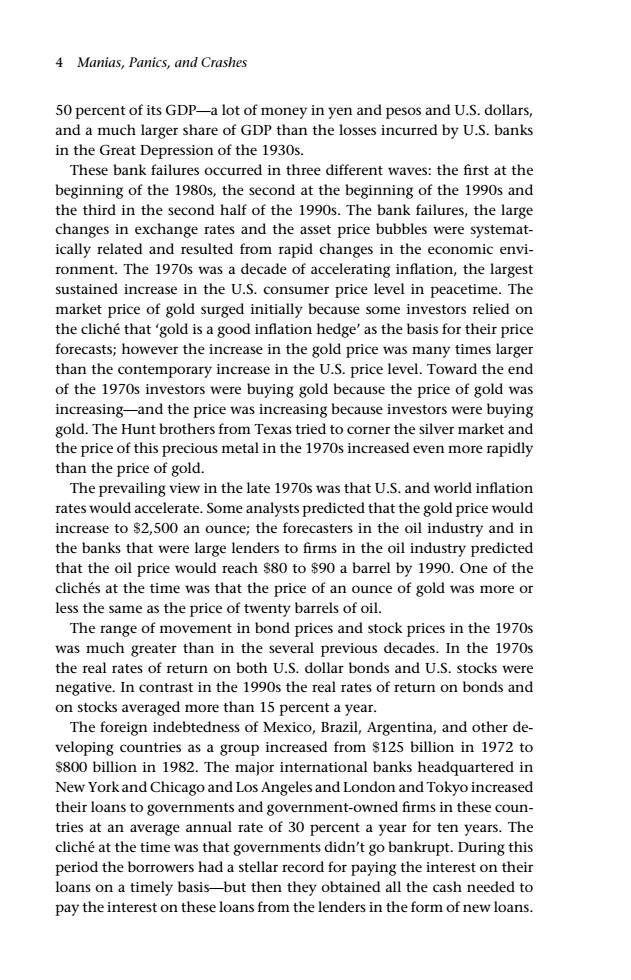正在加载图片...

4 Manias,Panics,and Crashes 50 percent of its GDP-a lot of money in yen and pesos and U.S.dollars, and a much larger share of GDP than the losses incurred by U.S.banks in the Great Depression of the 1930s These bank failures occurred in three different waves:the first at the beginning of the 1980s,the second at the beginning of the 1990s and the third in the second half of the 1990s.The bank failures,the large changes in exchange rates and the asset price bubbles were systemat- ically related and resulted from rapid changes in the economic envi- ronment.The 1970s was a decade of accelerating inflation,the largest sustained increase in the U.S.consumer price level in peacetime.The market price of gold surged initially because some investors relied on the cliche that 'gold is a good inflation hedge'as the basis for their price forecasts;however the increase in the gold price was many times larger than the contemporary increase in the U.S.price level.Toward the end of the 1970s investors were buying gold because the price of gold was increasing-and the price was increasing because investors were buying gold.The Hunt brothers from Texas tried to corner the silver market and the price of this precious metalin the 1970s increased even more rapidly than the price of gold. The prevailing view in the late 1970s was that U.S.and world inflation rates would accelerate.Some analysts predicted that the gold price would increase to $2,500 an ounce;the forecasters in the oil industry and in the banks that were large lenders to firms in the oil industry predicted that the oil price would reach $80 to $90 a barrel by 1990.One of the cliches at the time was that the price of an ounce of gold was more or less the same as the price of twenty barrels of oil The range of movement in bond prices and stock prices in the 1970s was much greater than in the several previous decades.In the 1970s the real rates of return on both U.S.dollar bonds and U.S.stocks were negative.In contrast in the 1990s the real rates of return on bonds and on stocks averaged more than 15 percent a year The foreign indebtedness of Mexico,Brazil.Argentina.and other de- veloping countries as a group increased from $125 billion in 1972 to s800 billion in 1982.The major international banks headquartered in New York and Chicago and Los Angeles and London and Tokyo increased their loans to governments and government-owned firms in these coun- tries at an average annual rate of 30 percent a year for ten years.The cliche at the time was that governments didn't go bankrupt.During this period the borrowers had a stellar record for paying the interest on their loans on a timely basis-but then they obtained all the cash needed to pay the interest on these loans from the lenders in the form of new loans. c01 JWBK120/Kindleberger February 13, 2008 14:58 Char Count= 4 Manias, Panics, and Crashes 50 percent of its GDP—a lot of money in yen and pesos and U.S. dollars, and a much larger share of GDP than the losses incurred by U.S. banks in the Great Depression of the 1930s. These bank failures occurred in three different waves: the first at the beginning of the 1980s, the second at the beginning of the 1990s and the third in the second half of the 1990s. The bank failures, the large changes in exchange rates and the asset price bubbles were systematically related and resulted from rapid changes in the economic environment. The 1970s was a decade of accelerating inflation, the largest sustained increase in the U.S. consumer price level in peacetime. The market price of gold surged initially because some investors relied on the cliche that ‘gold is a good inflation hedge’ as the basis for their price ´ forecasts; however the increase in the gold price was many times larger than the contemporary increase in the U.S. price level. Toward the end of the 1970s investors were buying gold because the price of gold was increasing—and the price was increasing because investors were buying gold. The Hunt brothers from Texas tried to corner the silver market and the price of this precious metal in the 1970s increased even more rapidly than the price of gold. The prevailing view in the late 1970s was that U.S. and world inflation rates would accelerate. Some analysts predicted that the gold price would increase to $2,500 an ounce; the forecasters in the oil industry and in the banks that were large lenders to firms in the oil industry predicted that the oil price would reach $80 to $90 a barrel by 1990. One of the cliches at the time was that the price of an ounce of gold was more or ´ less the same as the price of twenty barrels of oil. The range of movement in bond prices and stock prices in the 1970s was much greater than in the several previous decades. In the 1970s the real rates of return on both U.S. dollar bonds and U.S. stocks were negative. In contrast in the 1990s the real rates of return on bonds and on stocks averaged more than 15 percent a year. The foreign indebtedness of Mexico, Brazil, Argentina, and other developing countries as a group increased from $125 billion in 1972 to $800 billion in 1982. The major international banks headquartered in New York and Chicago and Los Angeles and London and Tokyo increased their loans to governments and government-owned firms in these countries at an average annual rate of 30 percent a year for ten years. The cliche at the time was that governments didn’t go bankrupt. During this ´ period the borrowers had a stellar record for paying the interest on their loans on a timely basis—but then they obtained all the cash needed to pay the interest on these loans from the lenders in the form of new loans